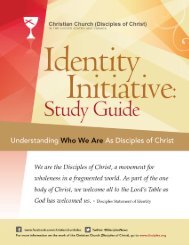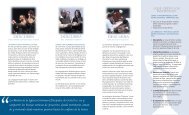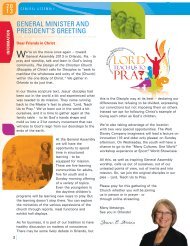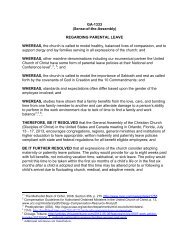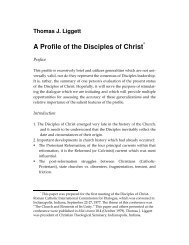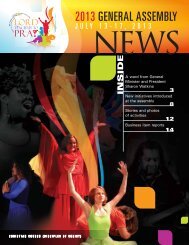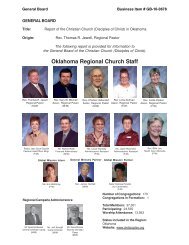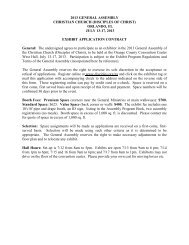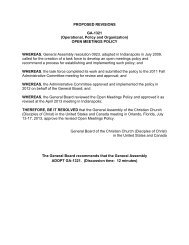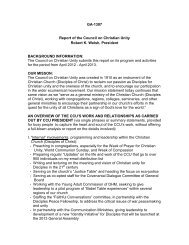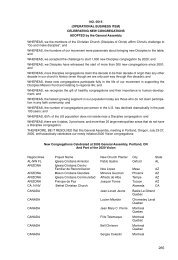RESOURCING THE CHURCH FOR ECUMENICAL MINISTRy A ...
RESOURCING THE CHURCH FOR ECUMENICAL MINISTRy A ...
RESOURCING THE CHURCH FOR ECUMENICAL MINISTRy A ...
You also want an ePaper? Increase the reach of your titles
YUMPU automatically turns print PDFs into web optimized ePapers that Google loves.
Dr. D. Newell Williams is the President of Brite<br />
Divinity School at TCU in Ft. Worth, Texas.<br />
Let me begin with three observations.<br />
1. The Christian Church (Disciples of Christ) in<br />
the United States and Canada cannot be<br />
inclusive without being multicultural. Thirtyfive<br />
percent of the US population is composed<br />
of minorities; it is projected that Anglos will be<br />
less than half of the US population by 2042.<br />
2. The Christian Church (Disciples of Christ)<br />
cannot be multicultural without being<br />
inclusive. We believe that unity is achieved not<br />
through coercion, but through the bonds of<br />
covenant.<br />
3. The Christian Church (Disciples of Christ)<br />
participates in the dominant North American<br />
culture which privileges Anglos. Therefore, we<br />
must be intentional about being a multicultural<br />
and inclusive church.<br />
The Christian Church (Disciples of Christ)<br />
participates in the dominant North American<br />
culture which privileges Anglos. Therefore,<br />
we must be intentional about being a<br />
multicultural and inclusive church.<br />
In light of these observations, I would like to raise<br />
three questions. Why should we be a multicultural<br />
and inclusive church? How can we be a multicultural<br />
and inclusive church? And, what impact<br />
does a commitment to being a multicultural and<br />
inclusive church have upon the practice of<br />
Christian unity? These are not new issues for<br />
What it Means to be a<br />
“Multicultural and Inclusive<br />
Church”<br />
D. Newell Williams<br />
18<br />
Disciples. To help stimulate discussion of these<br />
questions, I will present a case study of how we have<br />
addressed these issues in a church that has always<br />
included both African Americans and Anglo<br />
Americans.<br />
Why Should We Be a Multicultural<br />
and Inclusive Church?<br />
Our first general church ministries to African<br />
Americans were directed by Anglos who asserted<br />
that blacks would not trust a black in leadership.<br />
Consequently, African American Disciples organized<br />
their own regional and national conventions<br />
culminating in the establishment in 1917 of the<br />
National Christian Missionary Convention. The<br />
National Convention was an affiliate of the<br />
International (meaning the United States and<br />
Canada) Convention of the Disciples of Christ—<br />
which was the predecessor of the General Assembly<br />
of the Christian Church (Disciples of Christ) in the<br />
United States and Canada.<br />
In his inaugural address as president of the National<br />
Convention, delivered to a racially mixed assembly<br />
of forty-one Disciples leaders, the Rev. Preston<br />
Taylor, a formerly enslaved African American,<br />
stated why the Disciples of Christ must be a multicultural<br />
and inclusive church.<br />
The Disciples of Christ, strange as it may<br />
seem, need the colored people, if for no<br />
other reasons, as the acid test of Christian<br />
orthodoxy and willingness to follow the<br />
Christ all the way in his program of human<br />
redemption. For if the white brother can<br />
include in his religious theory and practice<br />
the colored people as real brothers, he will<br />
have avoided the heresy of all heresies.




